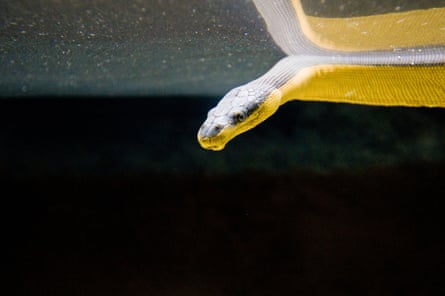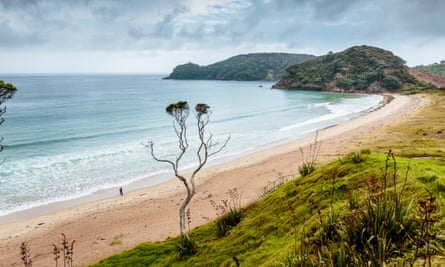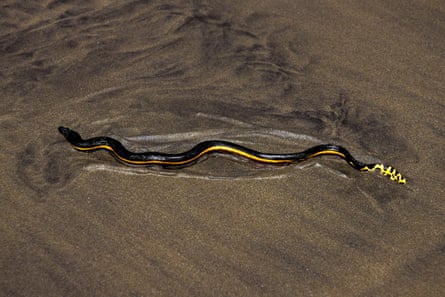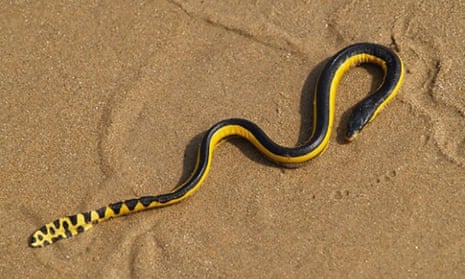It looked like a rope or a question mark – a black scribble on the sand. The creature had washed up on a Northland beach in May and was found by a steely local 11-year-old, who popped it into a bag, took it to his local corner shop and requested a box. The purveyor told him it was a sea snake, so the boy put it in a bucket and took it home. The snake did not survive the trip.
“I didn’t know what to do with it,” the boy told the New Zealand Herald. “I chopped its head off, put it in a bag and threw it out.”
Aotearoa has very few predators that could plausibly harm a person. Wandering the forests, your best bet for being attacked by a wild creature is probably an over-enthusiastic, amorous parrot – the country has no crocodiles, bears, wolves or scorpions. It also had no snakes – or so many people mistakenly believed.

The case in Northland was of one of a number of venomous sea snakes that cropped up on New Zealand beaches this year. Residents have videoed or photographed the reptiles at various beaches around the North Island. The sightings generated headlines – and some consternation – across New Zealand, which has no anti-venom in the country for the species.
“We’re so unfamiliar with snakes in New Zealand that people either don’t recognise that they’re a snake, or don’t think they’re poisonous, or don’t know how to behave around them,” says Department of Conservation specialist Clinton Duffy. Sometimes, he says, people misidentify them as native eels.
This article includes content provided by TikTok. We ask for your permission before anything is loaded, as they may be using cookies and other technologies. To view this content, click 'Allow and continue'.
On social media, news of snakes in Northland prompted an outpouring of sightings – and a number of mystified kiwis. “My cousin found one, wrapped it around his neck and took it to school … he assured the teacher it was dead – never seen one in his life as NZ has no snakes,” one commented.
“Since when did we have poisonous snakes in NZ, have I missed something,” an alarmed woman asked.
Another commenter relayed her experience catching a snake while fishing: “When we reeled it up we both looked and said that’s not a eel … knew it was some kind of snake so we both did the old farrrk that, and cut our line hook and all, see ya.”
A more accommodating climate

It’s not only New Zealand. Sea snake species have been cropping up in recent years in other regions and countries where they hadn’t been previously recorded, including Japan, South Korea and California. Researchers for the journal of Climate Change and Human Health found that “sea snakes are expanding their ranges and coming into contact with humans in unprecedented locations”.
“In the last few years we’ve been finding sea snakes in places we haven’t seen them before, whether it’s in really, really deep waters or in really high or low latitudes,” says Vinay Udyawer, a research scientist at the Australian Institute of Marine Science specialising in sea snake ecology and distribution.
As to why? It’s still a hypothesis, but scientists say that as global heating continues to drive rises in ocean temperature and stronger storms, encounters with sea snakes could become a more common experience for New Zealanders.
“It’s likely that with the changing temperatures, those regions might be more accommodating for sea snakes,” Udyawer says. “So they might be [part of a wider] trend for species that couldn’t sustain population in places like New Zealand, and might now have the ability to as waters get warmer.”
The most common sightings in New Zealand are of the yellow-bellied sea snake, a highly venomous but non-aggressive species common to warmer oceans. They spend their lives at sea, and generally come ashore only if they’re ill or have been washed up by storms and large waves. Yellow bellies are most happy in water temperatures of around 20C – so as oceans are warmed by global heating, they’ll become increasingly comfortable in some New Zealand waters. The average sea temperature in Northland already reaches 20 degrees in the summer months, but typically drops to around 16C in winter.

“The historic data we have shows they have been coming to New Zealand occasionally, and it seems that those sightings are happening more and more frequently every year,” Udyawer says. “Whether it’s changing temperatures or it’s more likely to be the increasing numbers of storms, or rough weather that might be bringing them – we still need to collect more information to resolve that.”
A privilege, not a nightmare
While news of sea snakes arriving has caused some alarm, they are classed as native to Aotearoa, having journeyed to these waters without human assistance. Their population may fluctuate, but yellow-bellies have likely been visiting New Zealand since before humans arrived.
“It’s really important that people realise that they are a protected species,” Duffy says. If New Zealanders see one, they should leave it alone and contact the Department of Conservation. “They shouldn’t harm them, and it’s a serious offence to kill one deliberately.”

And although these sea snakes are highly venomous, it is extremely rare for them to bite a human. “They have tiny fangs at the back of the mouth – to bite you, they really have to work,” Duffy says. He and Udyawer say the only known cases are when fishermen try to extract them from a net – occasionally, a snake will pierce the thin skin between their fingers.
“They can be thought of as scary and dangerous,” Udyawer says – but there’s little justification for that. Yellow-bellies are timid and docile, often curious about divers but not aggressive. “In terms of temperament, they are very, very different to what people think of as dangerous snakes,” he says.
While people should leave the creatures to their own devices, Udyawer says an encounter with a sea snake should be regarded as a privilege, not a nightmare.
“With all my years working with sea snakes, I still get really excited every time we see one – it’s still really difficult to actually see one in the wild. People should be aware how special it is.”

Comments (…)
Sign in or create your Guardian account to join the discussion